Finance Case Study: BSB's Interest Rate Risk Management and Hedging
VerifiedAdded on 2022/09/28
|5
|972
|23
Case Study
AI Summary
This case study analyzes BSB's interest rate risk and explores various hedging strategies. The case examines the sources of interest rate risk, including funds from Fannie Mae, new certificates of deposit (CDs), and commercial mortgages. It details the use of futures contracts (Treasury bill and Treasury bond futures) to hedge against interest rate fluctuations. The solution provides specific recommendations for hedging positions, considering the maturity of the exposures and the potential payoffs from these hedges. The document also discusses the risks associated with hedging, including margin requirements and the potential cost of hedging, and differentiates between static and dynamic hedging strategies. The case study concludes with a discussion of the best hedging strategies for BSB to minimize losses and maximize profits.
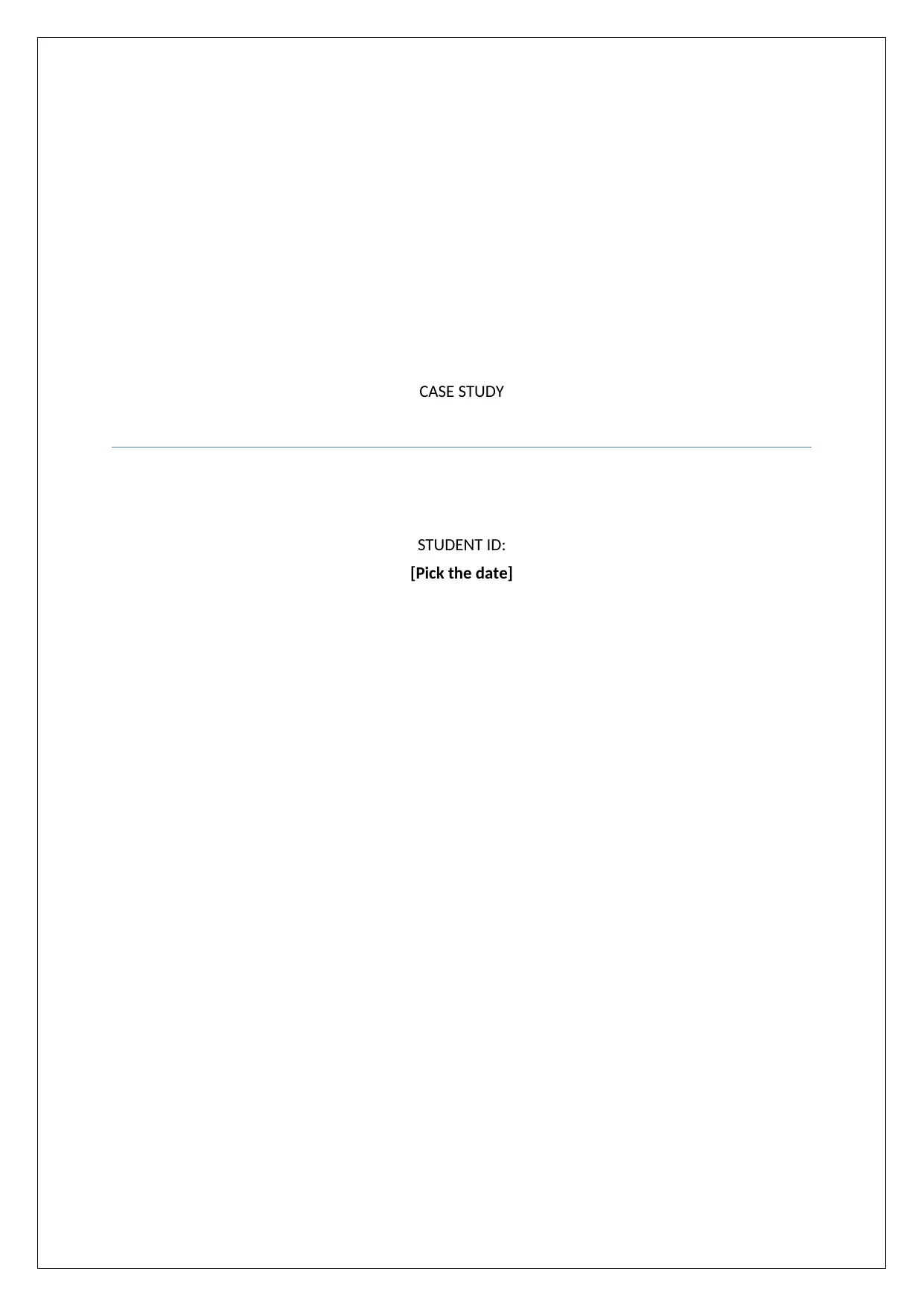
CASE STUDY
STUDENT ID:
[Pick the date]
STUDENT ID:
[Pick the date]
Paraphrase This Document
Need a fresh take? Get an instant paraphrase of this document with our AI Paraphraser
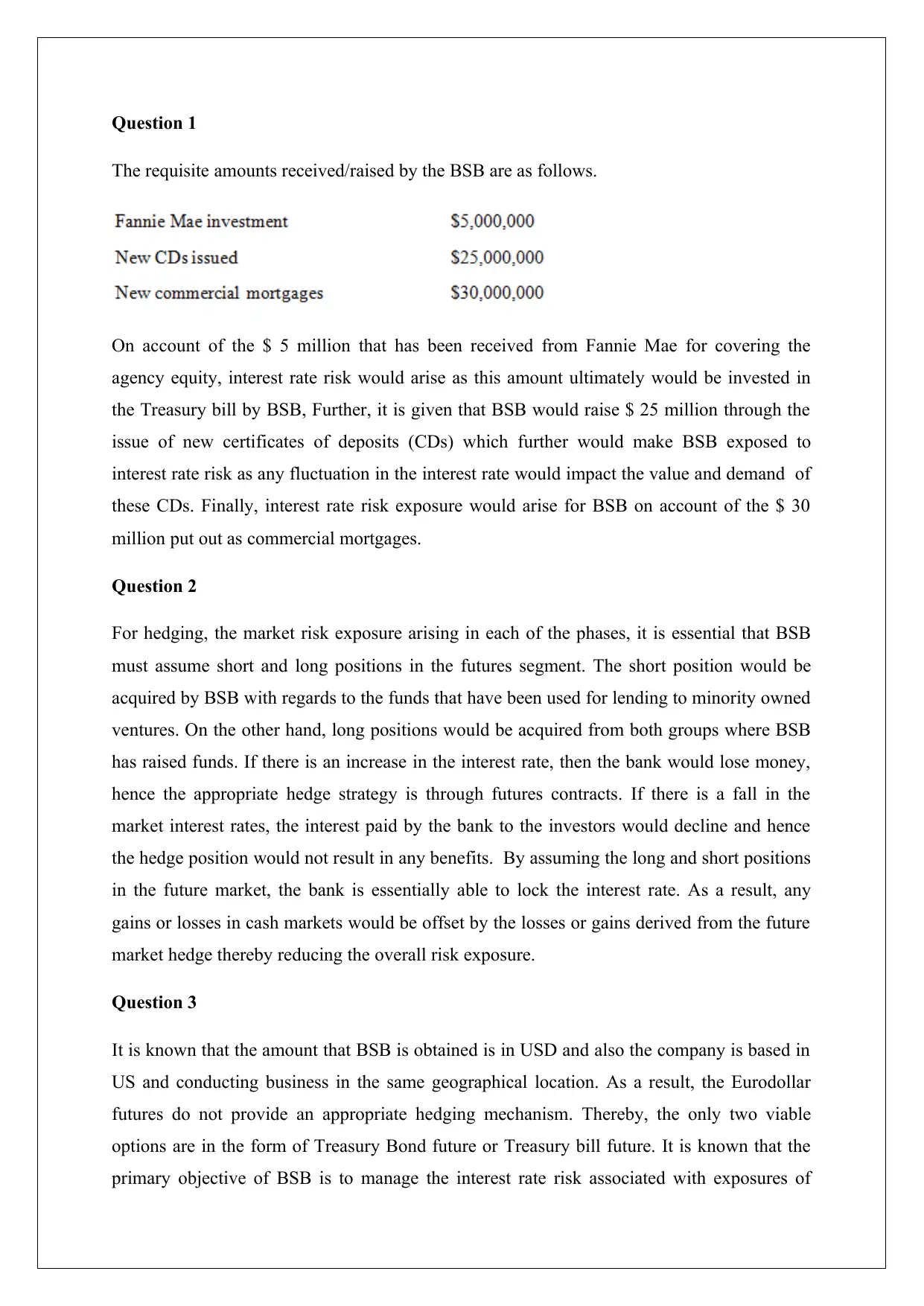
Question 1
The requisite amounts received/raised by the BSB are as follows.
On account of the $ 5 million that has been received from Fannie Mae for covering the
agency equity, interest rate risk would arise as this amount ultimately would be invested in
the Treasury bill by BSB, Further, it is given that BSB would raise $ 25 million through the
issue of new certificates of deposits (CDs) which further would make BSB exposed to
interest rate risk as any fluctuation in the interest rate would impact the value and demand of
these CDs. Finally, interest rate risk exposure would arise for BSB on account of the $ 30
million put out as commercial mortgages.
Question 2
For hedging, the market risk exposure arising in each of the phases, it is essential that BSB
must assume short and long positions in the futures segment. The short position would be
acquired by BSB with regards to the funds that have been used for lending to minority owned
ventures. On the other hand, long positions would be acquired from both groups where BSB
has raised funds. If there is an increase in the interest rate, then the bank would lose money,
hence the appropriate hedge strategy is through futures contracts. If there is a fall in the
market interest rates, the interest paid by the bank to the investors would decline and hence
the hedge position would not result in any benefits. By assuming the long and short positions
in the future market, the bank is essentially able to lock the interest rate. As a result, any
gains or losses in cash markets would be offset by the losses or gains derived from the future
market hedge thereby reducing the overall risk exposure.
Question 3
It is known that the amount that BSB is obtained is in USD and also the company is based in
US and conducting business in the same geographical location. As a result, the Eurodollar
futures do not provide an appropriate hedging mechanism. Thereby, the only two viable
options are in the form of Treasury Bond future or Treasury bill future. It is known that the
primary objective of BSB is to manage the interest rate risk associated with exposures of
The requisite amounts received/raised by the BSB are as follows.
On account of the $ 5 million that has been received from Fannie Mae for covering the
agency equity, interest rate risk would arise as this amount ultimately would be invested in
the Treasury bill by BSB, Further, it is given that BSB would raise $ 25 million through the
issue of new certificates of deposits (CDs) which further would make BSB exposed to
interest rate risk as any fluctuation in the interest rate would impact the value and demand of
these CDs. Finally, interest rate risk exposure would arise for BSB on account of the $ 30
million put out as commercial mortgages.
Question 2
For hedging, the market risk exposure arising in each of the phases, it is essential that BSB
must assume short and long positions in the futures segment. The short position would be
acquired by BSB with regards to the funds that have been used for lending to minority owned
ventures. On the other hand, long positions would be acquired from both groups where BSB
has raised funds. If there is an increase in the interest rate, then the bank would lose money,
hence the appropriate hedge strategy is through futures contracts. If there is a fall in the
market interest rates, the interest paid by the bank to the investors would decline and hence
the hedge position would not result in any benefits. By assuming the long and short positions
in the future market, the bank is essentially able to lock the interest rate. As a result, any
gains or losses in cash markets would be offset by the losses or gains derived from the future
market hedge thereby reducing the overall risk exposure.
Question 3
It is known that the amount that BSB is obtained is in USD and also the company is based in
US and conducting business in the same geographical location. As a result, the Eurodollar
futures do not provide an appropriate hedging mechanism. Thereby, the only two viable
options are in the form of Treasury Bond future or Treasury bill future. It is known that the
primary objective of BSB is to manage the interest rate risk associated with exposures of
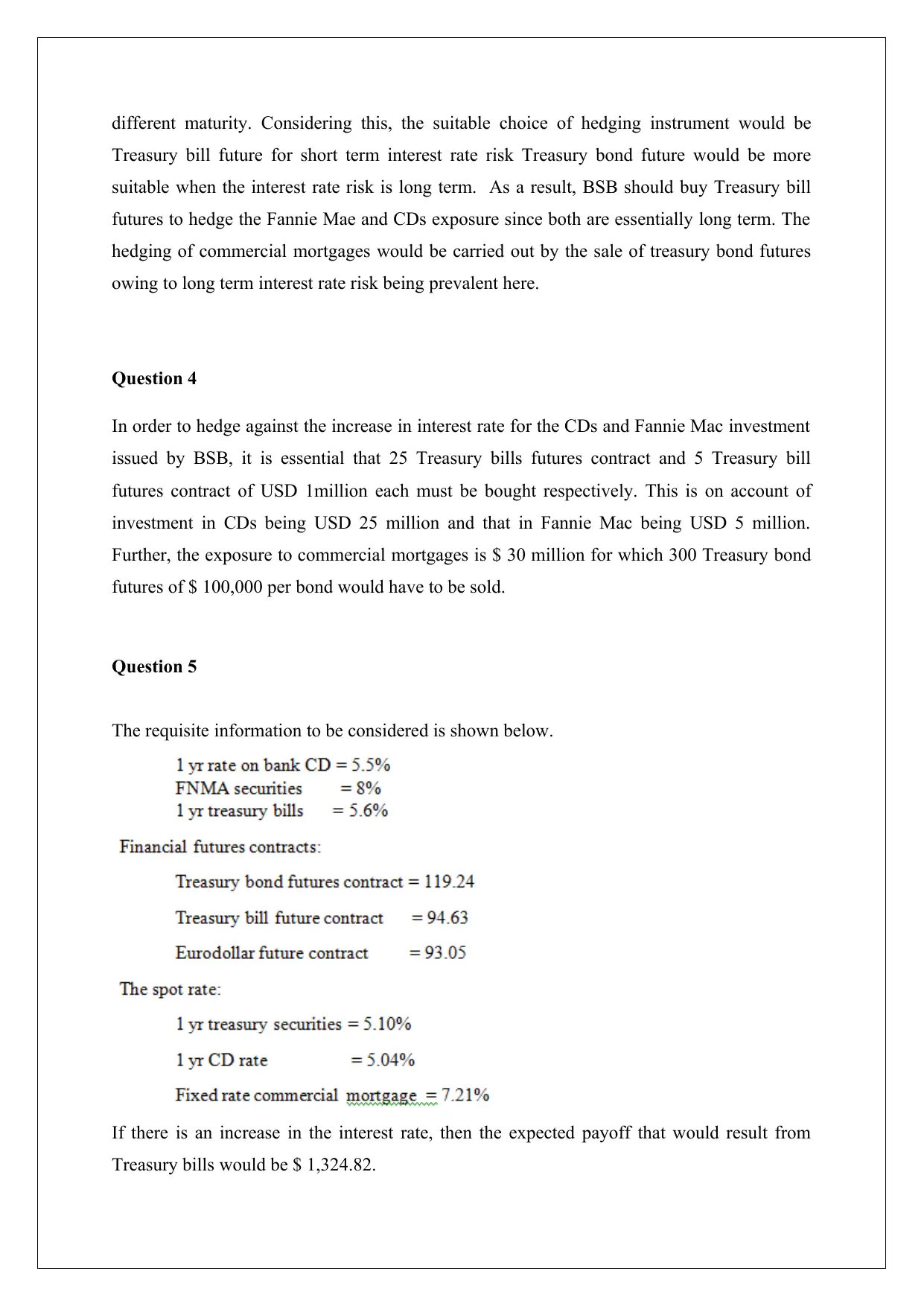
different maturity. Considering this, the suitable choice of hedging instrument would be
Treasury bill future for short term interest rate risk Treasury bond future would be more
suitable when the interest rate risk is long term. As a result, BSB should buy Treasury bill
futures to hedge the Fannie Mae and CDs exposure since both are essentially long term. The
hedging of commercial mortgages would be carried out by the sale of treasury bond futures
owing to long term interest rate risk being prevalent here.
Question 4
In order to hedge against the increase in interest rate for the CDs and Fannie Mac investment
issued by BSB, it is essential that 25 Treasury bills futures contract and 5 Treasury bill
futures contract of USD 1million each must be bought respectively. This is on account of
investment in CDs being USD 25 million and that in Fannie Mac being USD 5 million.
Further, the exposure to commercial mortgages is $ 30 million for which 300 Treasury bond
futures of $ 100,000 per bond would have to be sold.
Question 5
The requisite information to be considered is shown below.
If there is an increase in the interest rate, then the expected payoff that would result from
Treasury bills would be $ 1,324.82.
Treasury bill future for short term interest rate risk Treasury bond future would be more
suitable when the interest rate risk is long term. As a result, BSB should buy Treasury bill
futures to hedge the Fannie Mae and CDs exposure since both are essentially long term. The
hedging of commercial mortgages would be carried out by the sale of treasury bond futures
owing to long term interest rate risk being prevalent here.
Question 4
In order to hedge against the increase in interest rate for the CDs and Fannie Mac investment
issued by BSB, it is essential that 25 Treasury bills futures contract and 5 Treasury bill
futures contract of USD 1million each must be bought respectively. This is on account of
investment in CDs being USD 25 million and that in Fannie Mac being USD 5 million.
Further, the exposure to commercial mortgages is $ 30 million for which 300 Treasury bond
futures of $ 100,000 per bond would have to be sold.
Question 5
The requisite information to be considered is shown below.
If there is an increase in the interest rate, then the expected payoff that would result from
Treasury bills would be $ 1,324.82.
⊘ This is a preview!⊘
Do you want full access?
Subscribe today to unlock all pages.

Trusted by 1+ million students worldwide
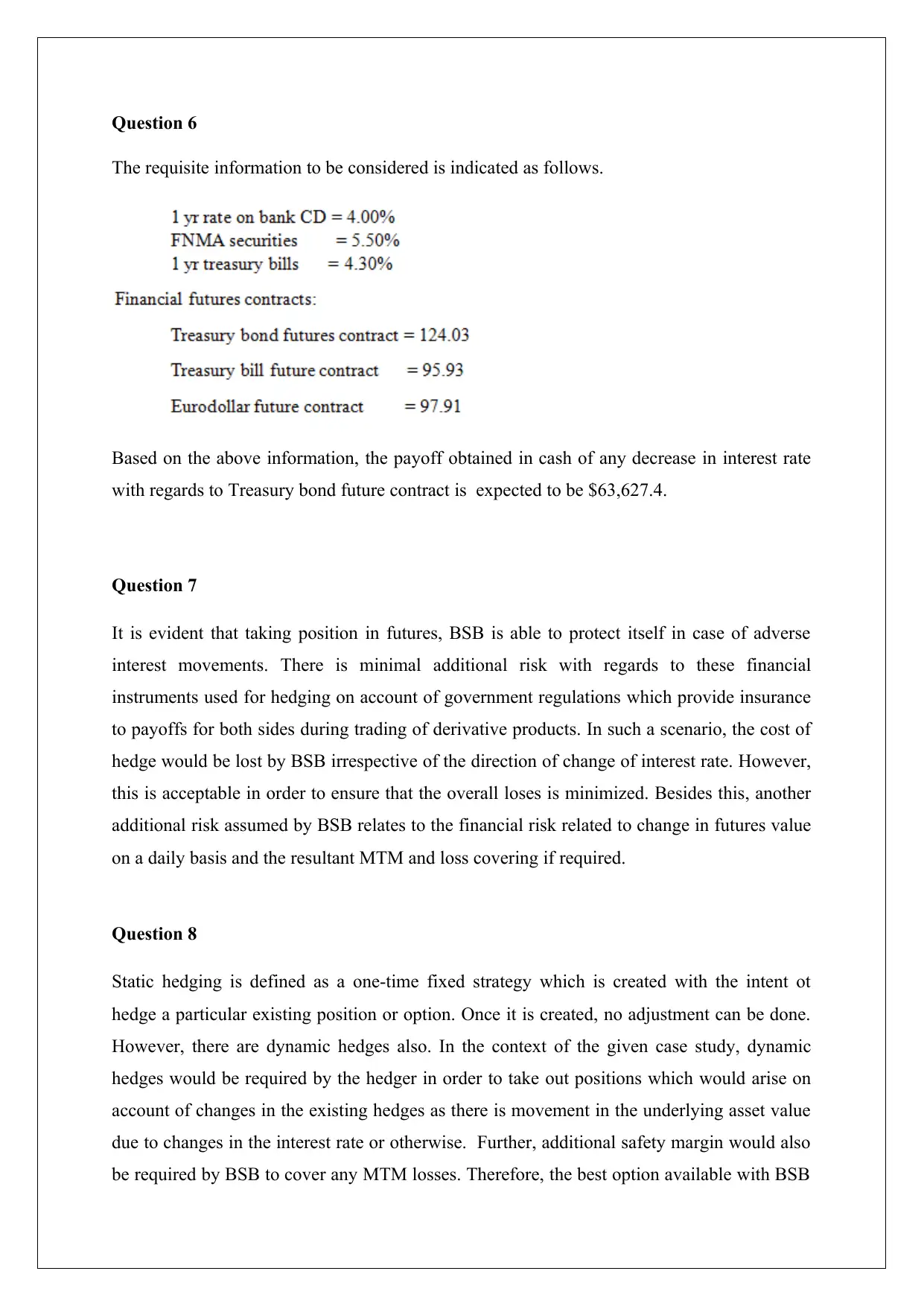
Question 6
The requisite information to be considered is indicated as follows.
Based on the above information, the payoff obtained in cash of any decrease in interest rate
with regards to Treasury bond future contract is expected to be $63,627.4.
Question 7
It is evident that taking position in futures, BSB is able to protect itself in case of adverse
interest movements. There is minimal additional risk with regards to these financial
instruments used for hedging on account of government regulations which provide insurance
to payoffs for both sides during trading of derivative products. In such a scenario, the cost of
hedge would be lost by BSB irrespective of the direction of change of interest rate. However,
this is acceptable in order to ensure that the overall loses is minimized. Besides this, another
additional risk assumed by BSB relates to the financial risk related to change in futures value
on a daily basis and the resultant MTM and loss covering if required.
Question 8
Static hedging is defined as a one-time fixed strategy which is created with the intent ot
hedge a particular existing position or option. Once it is created, no adjustment can be done.
However, there are dynamic hedges also. In the context of the given case study, dynamic
hedges would be required by the hedger in order to take out positions which would arise on
account of changes in the existing hedges as there is movement in the underlying asset value
due to changes in the interest rate or otherwise. Further, additional safety margin would also
be required by BSB to cover any MTM losses. Therefore, the best option available with BSB
The requisite information to be considered is indicated as follows.
Based on the above information, the payoff obtained in cash of any decrease in interest rate
with regards to Treasury bond future contract is expected to be $63,627.4.
Question 7
It is evident that taking position in futures, BSB is able to protect itself in case of adverse
interest movements. There is minimal additional risk with regards to these financial
instruments used for hedging on account of government regulations which provide insurance
to payoffs for both sides during trading of derivative products. In such a scenario, the cost of
hedge would be lost by BSB irrespective of the direction of change of interest rate. However,
this is acceptable in order to ensure that the overall loses is minimized. Besides this, another
additional risk assumed by BSB relates to the financial risk related to change in futures value
on a daily basis and the resultant MTM and loss covering if required.
Question 8
Static hedging is defined as a one-time fixed strategy which is created with the intent ot
hedge a particular existing position or option. Once it is created, no adjustment can be done.
However, there are dynamic hedges also. In the context of the given case study, dynamic
hedges would be required by the hedger in order to take out positions which would arise on
account of changes in the existing hedges as there is movement in the underlying asset value
due to changes in the interest rate or otherwise. Further, additional safety margin would also
be required by BSB to cover any MTM losses. Therefore, the best option available with BSB
Paraphrase This Document
Need a fresh take? Get an instant paraphrase of this document with our AI Paraphraser
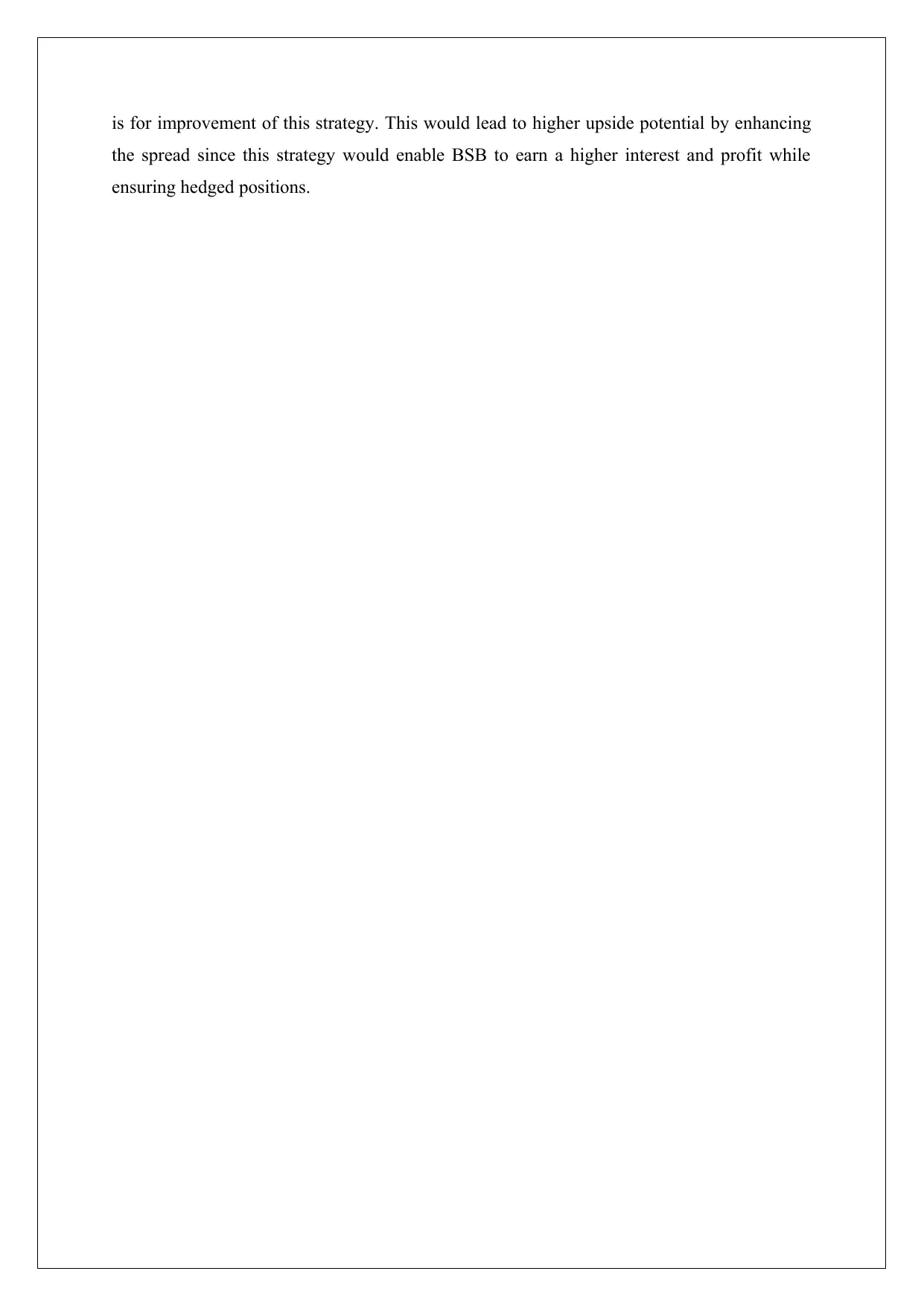
is for improvement of this strategy. This would lead to higher upside potential by enhancing
the spread since this strategy would enable BSB to earn a higher interest and profit while
ensuring hedged positions.
the spread since this strategy would enable BSB to earn a higher interest and profit while
ensuring hedged positions.
1 out of 5
Related Documents
Your All-in-One AI-Powered Toolkit for Academic Success.
+13062052269
info@desklib.com
Available 24*7 on WhatsApp / Email
![[object Object]](/_next/static/media/star-bottom.7253800d.svg)
Unlock your academic potential
Copyright © 2020–2025 A2Z Services. All Rights Reserved. Developed and managed by ZUCOL.




